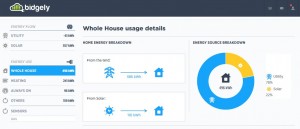The DOE continues to let its social media team win the internet. Yesterday, for Halloween, DOE changed its avatar to a version of the Netflix original series, Stranger Things.
Well done, DOE. Your energy for marketing remains top notch!
Making Electricity and Solar Usage Visible To The Naked Eye
By Yann Brandt
 Bidgely means Electricity in Hindi. And making your electricity usage at home understandable is the business of Bidgely, the company based in Sunnyvale, California. Electricity is this magical physics phenomenon that results in a bill at the end of the month, we use it almost every minute of the day but do we really know what is going on?
Bidgely means Electricity in Hindi. And making your electricity usage at home understandable is the business of Bidgely, the company based in Sunnyvale, California. Electricity is this magical physics phenomenon that results in a bill at the end of the month, we use it almost every minute of the day but do we really know what is going on?
The goal is to disaggregate your energy usage, which Bidgely calls ‘energy disaggregation’ through its platform filled with intelligent algorithms. By seeing the energy usage through green button or utility dashboards, the homebeat platform can tell you (the homeowner) what appliance is using the electricity. By showing you the details, it allows the user(s) of the home, to review their usage with a day lag and change their habits. Bidgely allows homeowners to use their system for free and all sharing of data is purely opt-in. The company is working throughout the Country but in some areas you may be required to install a monitoring hardware kit though the goal is to be hardware-free.
It may be complicated to see how a energy disaggregation tool has any meaning for the solar industry at first glance. Information and data will drive new users to reduce energy usage. Homeowners will want to battle each other for energy efficiency pride and being close to net-zero. It can also be foreseen, that solar companies and home energy service providers would benefit to see how much energy a home is using and how the pattern of usage affects the value of solar.
We continue to see the trend of utilities, homeowners, home automation and solar come together as we wrote a few months back (Is Google About To Be Your Cleantech Utility). Bidgely animates the story for everyone with data and algorithms. With their summer freedom campaign, utilities can use the Bidgely service free of charge for the next 2 years, so expect to see your energy bill come together on drier load at a time!
Intersolar North America, 3 levels of solar trends
By Yann Brandt
 In trying to find the market story, many of us travel to the trade shows. Last week was the time to attend Intersolar North America (ISNA) in San Francisco. A three level affair featuring the finest in solar gives a look into the window of solar as made up by each of us that attended. ISNA happens every July in the same place a few weeks after the largest solar show, Intersolar Europe in Munich. We had the opportunity to speak with Markus Elsässer, the Managing Director of Solar Promotion GMBH, who puts on the Intersolar show about the main trends of this year’s show. Trends that included energy storage, balance of systems and micro-grid solutions.
In trying to find the market story, many of us travel to the trade shows. Last week was the time to attend Intersolar North America (ISNA) in San Francisco. A three level affair featuring the finest in solar gives a look into the window of solar as made up by each of us that attended. ISNA happens every July in the same place a few weeks after the largest solar show, Intersolar Europe in Munich. We had the opportunity to speak with Markus Elsässer, the Managing Director of Solar Promotion GMBH, who puts on the Intersolar show about the main trends of this year’s show. Trends that included energy storage, balance of systems and micro-grid solutions.
The trade shows peaked alongside the solar industry in 2011, where the most companies exhibited at the shows before consolidation took over. The trends of participants has also changed in the past few years. Themes have largely shifted from manufacturing and modules towards soft costs and balance of systems.
With the focus on BOS and soft costs, ISNA saw the rise of energy storage as well. Some 40 companies had energy storage in their booth this year, in addition to the almost full time conference stage educating visitors about the topic. “With US solar still showing high soft costs, some best practices from other parts of the world can be shared,” said Markus about how companies are collaborating, “The learning is in both directions, as Germany transitions to a post feed-in-tariff market, companies are looking toward finance innovation from the US to bring back to Europe.”
Energy storage was a big factor affecting floor discussions about microgrids. Spun out from the projects in Puerto Rico where solar farms had to include some storage, some financing groups have been getting comfortable with including broader technologies into solar investments. We expect this trend to continue as post-Sandy thoughts come into play or areas where energy is above $0.20/kWh and power quality is unreliable.
Intersolar North America is part of a global solar presence, with Intersolar South America happening later this year in Brazil. The global presence and trade shows creates an opportunity for international partnerships for companies looking to grow in new markets.
The conference programming grew in 2014 over past years through the partnership with ASES. This year, conference attendees had the addition of almost 40 programs to learn from through the conference collocation. The conference for Intersolar is put together by a committee of 35 members, partnerships with 10 State solar groups and an extensive contractor day put on by CalSEIA. For anyone that thinks Intersolar North America is too ‘German’, 2014 showed the learning that can be had by coming to the show. At the very least it represents the best in solar at the annual Solar Battle of the Bands!
By Yann Brandt
 Solar is often presented in a complicated way to those not living in the industry on daily basis. We all know the headlines: bankruptcies, tariffs, utility smears and more. It is easy to understand that while solar enjoys a positive approval rating, there are legitimate questions. So when smart and successful people ask good questions and want to get on the supporting side of solar, I listen.
Solar is often presented in a complicated way to those not living in the industry on daily basis. We all know the headlines: bankruptcies, tariffs, utility smears and more. It is easy to understand that while solar enjoys a positive approval rating, there are legitimate questions. So when smart and successful people ask good questions and want to get on the supporting side of solar, I listen.
So the questions to be answered: Is solar’s current success permanent? And can it become profitable for investors in projects and companies? In a lighting round of updates, here is your current weather report for the solar industry.
Result of the tariff battles
Without a doubt, the tariffs imposed on solar equipment are bad for the industry. The latest round adds a cost of approximately $0.10-$0.15 cents per watt and brings the cost of modules into the mid $0.80s for larger purchases. These are costs that are going to impact the profitability of the value chain including the installer and financing party. In the end it increases the cost of solar electricity or slows the decrease of costs the industry has benefited from.
Companies will aim to work around the tariffs and will most likely open manufacturing lines in free-trade Countries like Mexico in the near future. SolarCity has already announced plans for their plant in New York and expect more of this to occur. In the meantime, don’t expect the tariff to slow the speed of development in the solar industry.
Markets and sectors
Solar can be separated into four categories: residential, commercial (private), commercial (public) and utility scale. In general, residential is growing (rapidly) and utility scale is now slowing year over year. Both of these segments have become very exclusive for investors, Wall Street with residential and utilities buying large solar farms. Commercial solar is primarily separated into investment grades. Good credits, like schools, government buildings and publicly traded companies, have access to scalable third party financing products. PPAs rule the commercial space which requires scale. All other commercial is essentially untouched and probably the biggest market opportunity alongside residential growth.
Markets are separated in geographies across the Country with each State representing multiple markets. Due to regulations and existing infrastructure costs, electricity customers see a different benefit from installing solar. Residential solar markets are now active in almost 20 States, getting us closer to a national effort to put solar on every home.
Effect of rising interest rates
Probably one of the biggest upsides to the solar industry is the cost of capital. Even in a low interest rate environment, solar projects still pay very high rates. Investors currently view solar as an investment with some risk with most investors seeking high single digit or low double digit returns. Solar debt in PACE markets still achieve project based returns above 6%, which is incredible considering that recent securitizations in PACE and residential solar have been in the 4.5% range.
Things are looking up however, with future securitizations continuing to drop the cost of capital in solar. Scale and more investor success will drive competition into these investments, therefore lowering the cost of capital further, one day matching the rates we see in residential and commercial mortgages.
What is hot in solar?
Software and financial innovation is driving more investment downstream in the sector. Financial models such as crowd funding and credit enhancements create an opportunity for more people to invest in and benefit from solar energy.
Software (cleanweb) is creating the ability for solar development platforms to lower the cost of each project. Developers are coming into solar to solve pricing inefficiencies, permitting issues and make complicated things like solar layouts an easy task. We continue to see financial and cleanweb startups making a very good case for more venture capital investment in solar.
What does solar need?
We cannot increase the amount of sunlight but we can add more participants in the industry. All of those angel investors that are funding the next software app or website should look for a solar version. Made money on a financial advisory firm? Invest in the next solar financing model. In short, solar needs the innovation that is happening to get more capital runway.
The importance of helping the development and efficiency of project development is that it helps the speed of project capital deployment. Billions of dollars are looking for a solar project to call home, the problem being that there are not sufficient investment opportunities in the marketplace.
Clouds in solar are causing the current turbulence we are encountering. The forecast however is sunny skies and smooth sailing in the near future. Hope you enjoy your trip in solar!